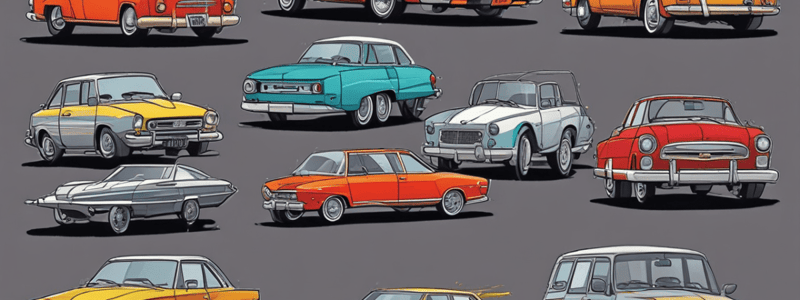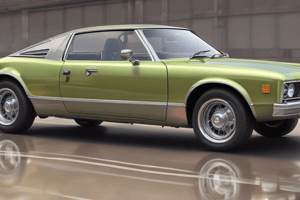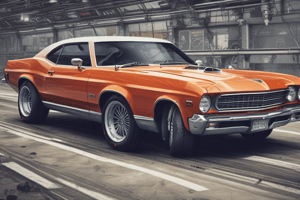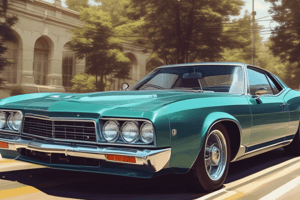Podcast
Questions and Answers
What is the primary characteristic of an Automobile?
What is the primary characteristic of an Automobile?
- It is a manually propelled vehicle
- It is a self-propelled vehicle which contains the power source for its propulsion (correct)
- It is a vehicle that can only carry goods
- It is a vehicle that can only carry passengers
What is the classification of a vehicle based on the number of wheels it has?
What is the classification of a vehicle based on the number of wheels it has?
- Body style
- Fuel used
- Transmission type
- Wheels (correct)
What type of vehicle uses a battery to drive?
What type of vehicle uses a battery to drive?
- Steam vehicle
- Electric vehicle (correct)
- Diesel vehicle
- Petrol vehicle
What is the classification of a vehicle based on the position of the engine?
What is the classification of a vehicle based on the position of the engine?
What type of vehicle has a manual transmission where gears need to be changed manually?
What type of vehicle has a manual transmission where gears need to be changed manually?
What is the classification of a vehicle based on the wheel drive?
What is the classification of a vehicle based on the wheel drive?
What is the term for the lowest position of the piston towards the crank end side of the cylinder?
What is the term for the lowest position of the piston towards the crank end side of the cylinder?
What is the function of the cylinder block in an engine?
What is the function of the cylinder block in an engine?
What is the purpose of the combustion chamber in an engine?
What is the purpose of the combustion chamber in an engine?
What is the function of the inlet manifold in an engine?
What is the function of the inlet manifold in an engine?
What is the purpose of the gudgeon pin in an engine?
What is the purpose of the gudgeon pin in an engine?
What is the function of the crankshaft in an engine?
What is the function of the crankshaft in an engine?
What is the frame of an automobile?
What is the frame of an automobile?
What is the term that refers to the underlying framework or structure that supports various components?
What is the term that refers to the underlying framework or structure that supports various components?
What type of chassis is commonly used in passenger cars and some SUVs?
What type of chassis is commonly used in passenger cars and some SUVs?
What is the term that refers to the inside diameter of the cylinder in an engine?
What is the term that refers to the inside diameter of the cylinder in an engine?
What is the term that refers to the topmost position of the piston towards the cover end side of the cylinder?
What is the term that refers to the topmost position of the piston towards the cover end side of the cylinder?
What is the network of small tubes or beams welded together to form a lightweight but strong framework in a chassis?
What is the network of small tubes or beams welded together to form a lightweight but strong framework in a chassis?
What is the main function of piston rings in a gasoline engine?
What is the main function of piston rings in a gasoline engine?
Which part of the engine is responsible for converting reciprocating motion into rotary motion?
Which part of the engine is responsible for converting reciprocating motion into rotary motion?
Why are diesel engines not preferred in commercial applications?
Why are diesel engines not preferred in commercial applications?
What is the purpose of the flywheel in a gasoline engine?
What is the purpose of the flywheel in a gasoline engine?
What is the advantage of diesel engines over gasoline engines?
What is the advantage of diesel engines over gasoline engines?
What is the function of the camshaft in a gasoline engine?
What is the function of the camshaft in a gasoline engine?
What is the primary advantage of a diesel engine?
What is the primary advantage of a diesel engine?
Which type of engine configuration is known for its smooth operation and good balance?
Which type of engine configuration is known for its smooth operation and good balance?
What is the primary purpose of engine balancing?
What is the primary purpose of engine balancing?
Which type of engine balancing addresses the forces caused by the rotating masses?
Which type of engine balancing addresses the forces caused by the rotating masses?
What is the purpose of balancing shafts in inline-4 engines?
What is the purpose of balancing shafts in inline-4 engines?
Which type of engine configuration is commonly associated with Porsche cars?
Which type of engine configuration is commonly associated with Porsche cars?
What is a primary benefit of engine balancing in terms of engine operation?
What is a primary benefit of engine balancing in terms of engine operation?
Which factor affects the balancing requirements of an engine?
Which factor affects the balancing requirements of an engine?
What is the purpose of ensuring consistent manufacturing tolerances in engine balancing?
What is the purpose of ensuring consistent manufacturing tolerances in engine balancing?
What is the primary difference between dynamic balancing and the bobweight method?
What is the primary difference between dynamic balancing and the bobweight method?
What is the main advantage of active balancing systems in modern engines?
What is the main advantage of active balancing systems in modern engines?
How do computational methods contribute to engine balancing?
How do computational methods contribute to engine balancing?
What is a key consequence of improper engine balancing?
What is a key consequence of improper engine balancing?
Why is engine balancing critical to engine design and manufacturing?
Why is engine balancing critical to engine design and manufacturing?
What is the primary benefit of using dynamic balancing in engine manufacturing?
What is the primary benefit of using dynamic balancing in engine manufacturing?
What is the main challenge of implementing engine balancing in engine design and manufacturing?
What is the main challenge of implementing engine balancing in engine design and manufacturing?
Flashcards are hidden until you start studying
Study Notes
Classification of Automobiles
- Automobiles are classified based on:
- Load: Heavy Transport Vehicle (HTV), Light Transport Vehicle (LTV), etc.
- Wheels: Two-wheeler, Three-wheeler, Four-wheeler, Six-wheeler, etc.
- Fuel used: Petrol, Diesel, Electric, Steam, Gas, etc.
- Body style: Sedan, Hatchback, Coupe, Station Wagon, Convertible, etc.
- Transmission: Conventional, Semi-automatic, Automatic
- Drive: Left-hand drive, Right-hand drive
- Driving axle: Front-wheel drive, Rear-wheel drive, All-wheel drive
Vehicle Construction and Components
- Main components of an automobile:
- Frame
- Chassis
- Body
- Power unit
- Transmission system
- Frame: The skeleton of the vehicle
- Types: Conventional, Semi-integral, Integral
- Chassis: The underlying framework of the vehicle
- Types: Body-on-Frame, Monocoque (Unibody), Backbone, Spaceframe, Platform
Engine Components
- Cylinder Block:
- Main supporting structure for engine components
- Cylinder head is mounted on top
- Crankcase is provided at the bottom
- Cylinder:
- Cylindrical vessel or space for piston movement
- Supported in the cylinder block
- Piston:
- Cylindrical component that fits into the cylinder
- Forms the moving boundary of the combustion system
- Combustion Chamber:
- Space enclosed in the upper part of the cylinder
- Fuel combustion takes place here
- Inlet Manifold:
- Pipe that connects the intake system to the inlet valve
- Air or air-fuel mixture is drawn into the cylinder
- Gudgeon Pin:
- Forms the link between the small end of the connecting rod and the piston
- Exhaust Manifold:
- Pipe that connects the exhaust system to the exhaust valve
- Products of combustion escape into the atmosphere
- Inlet and Exhaust Valves:
- Regulate the charge coming into the cylinder and the products of combustion
- Connecting Rod:
- Interconnects the piston and the crankshaft
- Transmits the gas forces from the piston to the crankshaft
- Crankshaft:
- Converts the reciprocating motion of the piston into useful rotary motion
- Enclosed in a crankcase
Gasoline Engine
- Basic parts of a gasoline engine:
- Cylinder block
- Piston
- Piston rings
- Piston pin
- Connecting rod
- Crankshaft
- Cylinder head
- Intake valve
- Exhaust valve
- Camshaft
- Timing gears
- Spark plug
Advantages and Disadvantages of Diesel Engines
- Advantages:
- Better fuel economy
- Longer engine life
- Disadvantages:
- Heavier and more expensive
- Lower maximum RPM ranges
- Must be fuel injected
- Produce more smoke
- Harder to start in cold weather
- Noisier and tend to vibrate
Multiple Cylinder Engines
- Common configurations:
- Inline engines (I2, I3, I4, I5, I6)
- V engines (V6, V8, V10, V12)
- Boxer (Flat) engines (F4, F6)
- Rotary engines
- Factors influencing engine configuration:
- Vehicle size
- Performance requirements
- Fuel efficiency goals
- Manufacturer preferences
Engine Balancing
- Importance of engine balancing:
- Smooth operation
- Minimize vibrations
- Optimize performance
- Types of engine balancing:
- Primary balancing (reciprocating masses)
- Secondary balancing (rotating masses)
- Methods of balancing:
- Balancing shafts
- Counterweights
- Engine layout optimization
- Benefits of engine balancing:
- Smooth operation
- Improved reliability
- Performance optimization
- Considerations in balancing:
- Engine speed and application
- Manufacturing tolerances
- Cost and complexity
- Balancing techniques:
- Dynamic balancing
- Bobweight method
- Modern developments:
- Active balancing systems
- Computational methods (CAD, simulation, CFD, FEA)
Studying That Suits You
Use AI to generate personalized quizzes and flashcards to suit your learning preferences.





